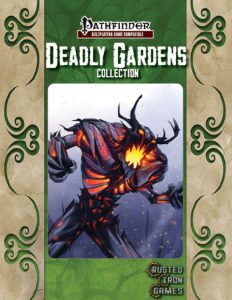Deadly Gardens Collection

This massive collection of the Deadly Gardens-series clocks in at 76 pages, 1 page front cover, 1 page editorial, 1 page introduction/ToC, 1 page SRD, 1 page inside of back cover, 1 page back cover, leaving us with a massive 70 pages of content, so let’s take a look!
The Deadly Gardens-series has, so far, provided quite a smattering of plant-creatures and related material, and this book collects the material in a handy compilation. From the get-go, we can see that this is not simply all the pdfs tacked together – the content has been reorganized in a sensible manner.
We begin the book with 4 new feats, which center around a couple of crucial components: There are feats that allow for the harvesting of poison from living creatures, for better resilience versus poisons, and, most interestingly perhaps, one that allows you to use poisons to treat diseases and addictions. The other key-feat included herein would be the Deadly Gardener-feat, which lets you Handle Animal plants without the DC-penalty, and even handle unintelligent plants and use wild empathy, if available, in conjunction with them. As far as organization is concerned, I’d have appreciated the plant companion stats that are provided for some creatures to feature here in the beginning as well – instead, they are located in the individual plant creature entries, which is slightly inconvenient, as most GMs probably wouldn’t want to hand out the creature-information.
From here, we get a couple of natural hazards like quagmires, and then move on to one of my favorite aspects of the series – the expansion of mechanically-meaningful terrain types – from kudzu to salt flats to razor shale and scree types, there are quite a few really amazing means to make combat more exciting and dynamic here. As a minor complaint: Damage types generally are concise, and so are the rules, but the scree types don’t mention the proper damage type they inflict –it is readily apparent that bludgeoning is correct here, though. Analogue, thickets should probably inflict piercing damage. These are cosmetic gripes, but I figured they’d warrant mentioning.
The next chapter is one of the hearts of the book, and seriously one of the best reasons to get the book: We receive a massive item-chapter. And I mean *massive* – if you’ve been following the series, you’ll know that it has championed natural items long before the release of Ultimate Wilderness, and did so rather well. Particularly for low level games and campaigns that enjoy a down-to-earth tone or a more dark fantasy and/or low/rare magic-approach, this’ll deliver in spades! If you’re like me and adore Playground Adventures’ fantastic Creature Components-books, then it should be noted that use of the books in conjunction is a pretty painless procedure!
Category-wise, the book first lists 5 alchemical items that include oil that hardens plant skin, liquid fertilizers, salt bombs, and the like – these are neat, but on a formal level, I noticed that sometimes there is a blank space between the gp amount and “gp”, and sometimes there isn’t. The salt bomb also mentions salt damage, which technically doesn’t exist, but seeing how circumstantial its effects are, I don’t necessarily object to that here to the extent where I’d usually do. The book then goes on to present 8 herbal remedies that range from aloe and lavender, to super-hot peppers that may sicken you with heat, but also help stave off the cold. Their benefits are subdued, nice and would theoretically be appropriate in even a no-magic game. Here, I have no nitpicks. The lion’s share of the items herein, though, are natural items – they note a source creature, the related skill check and the yield you can get from the target – as well as the price these components fetch on the market. The rules for preserving them are as simple and painless as the base engine. While quite a few of the natural items listed here are sourced from the new plant monsters that may be found within these pages, the majority hail from classic critters like intellect devourers, leucrottas, etc.
The eyes of accuser devils, for example, may be used as a kind of grotesque video camera that records things it sees; achaierai oil can be added to flame to create noxious, nauseating and nasty black smoke. Adherer tendrils may be used to facilitate the creation of sovereign glue. The voice-boxes of androsphinxes may be used to double the range of sound-based spells when used as a material component. Blood root vitae can be used to heal and also lesser restoration targets. Boggard tongues can be used as impromptu bungee ropes, while bulette musk is a kind of aphrodisiac that helps you influence those attracted to you via Diplomacy (Skill-reference not properly capitalized). The items also include e.g. items that can act as insect-repellant, as a power component to enhance fire magic, provide metamagic synergy, etc. I am still not a big fan of the cyclops eye soup, which makes the next critical threat within 8 hours automatically confirm. There are also small hiccups in the otherwise generally well-made rules language here – for example, an item that deals sonic damage, but its splash damage fails to properly type the splash damage’s damage type as sonic. This doesn’t impede the functionality of the items, but if you’re as anal-retentive as I am regarding these components, it may bug you here and there – a careful additional pass regarding rules-integrity could have further increased the value of this section. (As an aside – some of the glitches of the individual pdfs that I called out in my individual reviews have actually been rectified, so kudos for those!)
Beyond the ton of items, a massive table of almost 2 pages of natural poisons and 4 power components can also be found here. The book includes a new special material, an armor quality to grant/enhance woodland stride, and a whole array of magic items that include particularly smelly onions that you can eat to become really unappealing to eat (or get near…); there are classic quickly-growing beans, a silver apple that acts as a lycanthrope detector. The rules here generally are solid as well, often doing interesting things (such as with an assassin vine-based whip that can constrict on its own), but there also are some instances where damage is untyped that shouldn’t be.
Now, obviously, this being a compilation, the book also contains the stars of the Deadly Gardens-series – the monsters! From the lowly ophidian vine to the CR 23 Kaiju Verdaxag (who comes with a summary of kaiju traits and a spell to call for its wrath), the book contains a lot of interesting critters – and while it’s not included in the bookmarks, the wandering sundew is actually included in the book. The artworks btw. are sometimes glorious b/w (like the hypno-lotus) and sometimes in full color – in most instances, I ended up liking the b/w-pieces a bit more, though exceptions exist. Now, I really don’t enjoy repeating myself too much, so if you want a critter-by-critter discussion of everything within this tome, please do consult my reviews of the individual Deadly Gardens-installments.
Conclusion:
Editing and formatting are pretty good on a rules language level, but on a formal level, there are still a couple of minor hiccups present herein that should have been caught. Layout adheres to a nice and generally printer-friendly two-column standard, with matte backgrounds. The artworks are, for the most part, really nice, particularly considering the super-indie niche of the series. Really impressive! The pdf comes fully bookmarked for your convenience, making navigation comfortable.
Russ Brown, Matthew Carroll, Kim Frandsen, Jeff Gomez, Chris Hunt, Sam Kaplan, Joe Kondrak, Jacob W. Michaels, Stephen Stack, Andrew Umphrey, Isaac Volynskiy, Mike Welham – considering this cadre of authors, it is pretty impressive to note how unified this book ultimately is. Compilations are difficult for me – on the one hand, I don’t want to unduly repeat myself; on the other, I still need to present valid advice and check the book. So yeah, this was a bunch of work, but work I’m glad I invested my time in.
There is value in this compilation, and it lies in convenience and organization – in contrast to the individual pdfs, you can have all those small tidbits and items all at the flick of the wrist, conveniently-presented in one book, and this ultimately renders the book a useful resource. If you do NOT have any Deadly Gardens installments so far, then this is most definitely the iteration I’d recommend getting. However, if you already have them, the usefulness of the compilation lies primarily in its unified presentation and organization. So yeah, as a whole, I consider this to be a good compilation product. While I would have loved to report that is has gotten rid of the small tidbits and inconsistencies, there are a few still here that made me wish this had received another editing pass to remove the remaining aesthetic blemishes. This notwithstanding, we have a rather nice book here, though my final verdict can’t exceed 4 stars for it – a good book, and an excellent resource if you’re new to the horrific plant-threats and natural items presented by the series.
You can get this massive collection here on OBS!
If you’re enjoying my reviews, please consider supporting me here on patreon!

Endzeitgeist out.

Thank you so much for the review Endz!
I do have a bit of news regarding this collection as well. First of all, this will be our first print on demand product which I hope to have available soon! In preparation for this, I have done multiple editing passes on the entire document in order to clean up various grammatical and rules formatting issues before committing to the print version. Like some items having the weight in fractions and others in decimals – an artifact of combining the multiple pdfs that occurred in some early versions of the release.
There will also be some content changes which include the following:
-Layout changes to ensure monster entries align with page-breaks, so monsters take 1, 2 or 3 full pages.
-Page count increased to 82 pages, which due to the layout changes actually includes about 8 pages worth of new content!
-At least 1 new hazard
-Some new/updated art
-Some problematic items (like Sard Sap) updated or replaced entirely.
-Plant companions moved to their own section!
-All monsters included in Bestiary (except Verdaxag) will have a natural item (there were a couple of omissions).
-5 entirely new plant monsters only available in this collection – all written by Mike Welham!
Of course, anyone who has already bought the collection will get the updated version for free once it is released.
Hej Russ!
That’s awesome news!! Do tell me when the updated book hits sites, and I’ll immediately revsie the review accordingly to ensure that it reflects the improvements made!
Cheers!